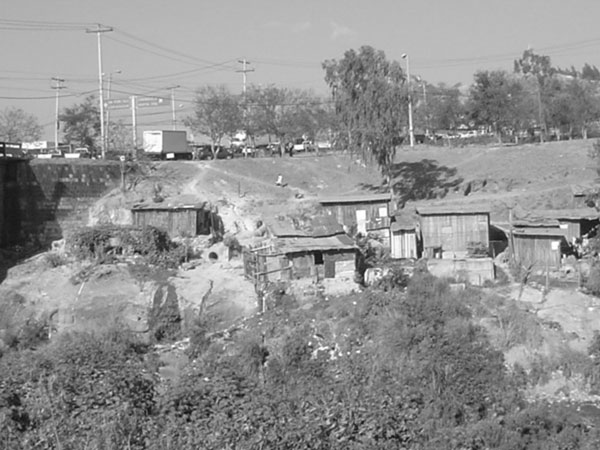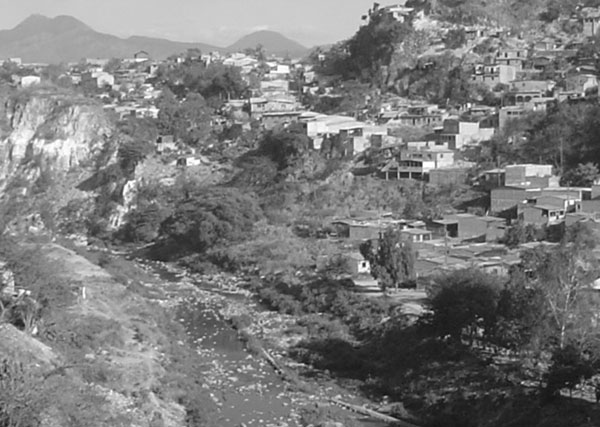

Latin America and the Caribbean
 |
 |
| International
Strategy for Disaster Reduction Latin America and the Caribbean |
Newsletter
ISDR Inform - Latin America and the Caribbean |
 |
|
Contributions
|
| As vulnerable as always?
Margarita
Gascón, gascon@lab.cricyt.edu.ar From time to time, everyday life in urban environments is interrupted by a natural disaster. Images of floods, earthquakes, hurricanes, and other destructive natural events appear in the media and awaken our sense of horror, surprise, and solidarity with those affected. For years the scientific community has devoted time and energy to better understand these events, study the possibilities of technological applications, and advance in the area of predicting such events, in order to reduce the existing vulnerability among the population and mitigate the impact of disasters on both the environment and society. Despite their effects, catastrophes are often forgotten or fade into memory. A massive natural disaster always serves as a magnifying glass, drawing attention to behaviors, tendencies and tensions that had previously been concealed by routine. A disaster puts us face to face with nature and its force, and with our technological ability to mitigate it. It also makes us confront wealth and poverty, and the ability of some people to turn a tragedy into a business.
|
|
|
|
For instance, the El Niño phenomenon has for decades caused changes in the distribution of rainfall. In the 19th century, it caused famines that killed millions of people throughout a vast region stretching from the Sudan to China. Also, an article published in1993 highlighted how difficult it was to predict famines in sub-Saharan Africa due to their connection to the El Niño phenomenon.2 In the Andean region of Ecuador and Peru, it has been proven that this phenomenon is not new.3 In 1581, the following couplet announced unusually intense rains along the dry, northern coast of Peru: In Trujillo and its valleys An important aspect of this phenomenon is its political consequences. In 1460, droughts associated with El Niño-La Niña phenomena caused hunger and plagues which created an environment ripe for political crisis within the Inca Empire in Peru. Later, in 1585, torrential rains destroyed the city of Lambayaque, home of the Moche culture in Peru, leading to the downfall of the governor, who was accused of having caused the rains by moving the site of a statue honoring the city’s founder.4 In the Northern hemisphere,
records indicate changes in the Gulf Stream in 1837 and 1838 that caused
the sea between Norway and Denmark to freeze
over, essentially connecting the two countries. The Gulf Stream has also
experienced other changes that kept summer temperatures in Holland from
exceeding 14ºC (57ºF). Thus, concerns that the effects of global
warming may intensify extreme weather conditions are legitimate.5
|
 |
|
Nevertheless, we should avoid the tendency of always placing human beings at center stage. Nature is immensely superior and certain natural disasters are extremely difficult and even impossible to control, beyond some basic measures of mitigation and prediction. Let us remember that life was on the verge of extinction during the Permian period, when repeated volcanic eruptions contaminated the air, land and water, causing the extinction of 95% of the planet’s species. With such an event of that magnitude in mind, a worrisome question arises: to what extent could our modern technology prevent destruction if a similar catastrophe were to occur in populated areas? Many times we are hardly able to forecast and control the negative effects of recurring disasters, including tropical storms and hurricanes (such as the recent Hurricane Katrina). From certain viewpoints, political concern over weapons of mass destruction
and international terrorism as threats to people in cities is entirely
well-founded. However, if predictions regarding the tendency toward extreme
weather are confirmed, natural disasters could cause much more damage
in more cities. |
 |
|
Politicians and government officials face a range of important questions considering their responsibility for reducing vulnerability: Can we prevent it? If so, how? Can we mitigate the effects of disasters? Do early warning systems work? How much do these systems cost? It seems like the last two are the most frequent questions, given the potential applications of early warning systems, such as using satellite images of tropical storms, hurricanes or typhoons. Japan, for example, has an early warning system that allows this country to reach an acceptable level of tsunami forecasting. Nevertheless, it has been pointed out that the implementation of early warning systems is only one step that must be accompanied by a costly system of maintenance and an emergency action plan known to the public (no warning system will work if the population does not know what to do in response). Similarly, while engineering can provide one response from a scientific and technological perspective, it must be accompanied by a social response focusing on education and participation. Prevention measures and efforts to reduce vulnerability should involve those who will be affected. To date, plans revolve mostly around how to act during an emergency. Rescue and relief are certainly crucial, but are not by themselves sufficient. We must also save the urban infrastructure that makes daily life possible. If not, the damages will be paid for in higher taxes and greater debt, with an overall negative effect on the poorest sectors. Vulnerability reduction is, in many ways, a commitment to achieve an overall more secure society. For additional information please contact: 1- Margarita Gascón, editor. Vientos, tsunamis, terremotos y
otras catástrofes naturales. Historia y casos latinoamericanos.
Buenos Aires, Biblos, 2005 (summary).
|
| © UN/ISDR |